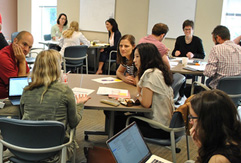Evaluation Observation Instructions: Difference between revisions
m (Add (at least 3-4 from each Indicator: Climate, Structure, Vibrancy) to first step) |
No edit summary |
||
| (One intermediate revision by the same user not shown) | |||
| Line 4: | Line 4: | ||
2. As part of an '''official observation'''. With the observer, follow Steps 1 – 5 below. The notes and class observation will form the basis of an observation report. | 2. As part of an '''official observation'''. With the observer, follow Steps 1 – 5 below. The notes and class observation will form the basis of an observation report. | ||
The success of this new faculty peer observation process hinges on the mindset of both the observer and the observee. For the process to be most effective, the observee should be genuinely committed to professional growth as an instructor, while the observer should act as a supportive partner, providing an additional perspective on the specific behaviors and practices the observee wishes to refine. The emphasis is on providing formative feedback that fosters reflection and growth strategies, rather than on delivering a summative assessment for faculty evaluation. With that in mind, the tool's use in evaluating teaching for retention, tenure, and promotion occurs when the teaching observation is assessed alongside the faculty’s reflection on the observation report, which outlines strategies for continuous improvement. | |||
{| class="wikitable" | {| class="wikitable" | ||
|[[File:Step familiarizewithtool.jpg|alt=Computer book and coffee|frameless]] | |[[File:Step familiarizewithtool.jpg|alt=Computer book and coffee|frameless]] | ||
| Line 10: | Line 12: | ||
|- | |- | ||
|[[File:Step facultymeeting.jpg|alt=Faculty meeting|frameless]] | |[[File:Step facultymeeting.jpg|alt=Faculty meeting|frameless]] | ||
|'''Step 2:''' Meet with the observer (15min). Discuss your overarching goals for the observation and the list of observable behaviors you want to focus on. Together with the observer, narrow down the list to | |'''Step 2:''' Meet with the observer (15min). Discuss your overarching goals for the observation and the list of observable behaviors you want to focus on. Together with the observer, narrow down the list to 6-10 observable behaviors (at least 2-4 from each Indicator: Climate, Structure, Vibrancy), using the feedback from the discussion with the observer who may have given feedback on additional/alternative ways you could get at your goal. Create a [https://observations.vercel.app tailored observation tool] with only your selected behaviors that your observer can use. | ||
|- | |- | ||
|[[File:Step selectdates.jpg|alt=Select Dates|frameless]] | |[[File:Step selectdates.jpg|alt=Select Dates|frameless]] | ||
| Line 21: | Line 23: | ||
|'''Step 5''': Meet with the observer to debrief (15-min). The observer will provide a copy of the tool and notes to the observed instructor. If during the discussion, areas of growth are identified, then the '''[[Repository|Eco-STEM repository]]''' can be a useful resource providing research articles or examples on how one might implement specific strategies. | |'''Step 5''': Meet with the observer to debrief (15-min). The observer will provide a copy of the tool and notes to the observed instructor. If during the discussion, areas of growth are identified, then the '''[[Repository|Eco-STEM repository]]''' can be a useful resource providing research articles or examples on how one might implement specific strategies. | ||
|} | |} | ||
'''FAQ''' | |||
'''Note on the scalability of this process''' | '''Note on the scalability of this process''' | ||
Latest revision as of 13:49, 29 August 2024
The ECO-STEM Peer Observation Tool can be used in a variety of ways for the Retention, Tenure, and Promotion process.
1. As part of a self-reflection. In this case, see instructions for Peer-Observation (faculty observe each other teaching).
2. As part of an official observation. With the observer, follow Steps 1 – 5 below. The notes and class observation will form the basis of an observation report.
The success of this new faculty peer observation process hinges on the mindset of both the observer and the observee. For the process to be most effective, the observee should be genuinely committed to professional growth as an instructor, while the observer should act as a supportive partner, providing an additional perspective on the specific behaviors and practices the observee wishes to refine. The emphasis is on providing formative feedback that fosters reflection and growth strategies, rather than on delivering a summative assessment for faculty evaluation. With that in mind, the tool's use in evaluating teaching for retention, tenure, and promotion occurs when the teaching observation is assessed alongside the faculty’s reflection on the observation report, which outlines strategies for continuous improvement.

|
Step 1: (Instructor individually)
Familiarize yourself with the tool by using the summary version of the observation tool. It is broken into the three areas of climate, structure, and vibrancy. You may have identified an aspect of your class that you want to change – think about which of the observable behaviors of students and faculty relate to that aspect. Narrow down your list to 10-15 observable behaviors (at least 4-6 from each Indicator: Climate, Structure, Vibrancy). For more information on any of the observable behaviors, please see the corresponding entry in the Eco-STEM repository. |

|
Step 2: Meet with the observer (15min). Discuss your overarching goals for the observation and the list of observable behaviors you want to focus on. Together with the observer, narrow down the list to 6-10 observable behaviors (at least 2-4 from each Indicator: Climate, Structure, Vibrancy), using the feedback from the discussion with the observer who may have given feedback on additional/alternative ways you could get at your goal. Create a tailored observation tool with only your selected behaviors that your observer can use. |

|
Step 3: Agree on an observation and debrief date. |

|
Step 4: Observation takes place using tailored observation form. |

|
Step 5: Meet with the observer to debrief (15-min). The observer will provide a copy of the tool and notes to the observed instructor. If during the discussion, areas of growth are identified, then the Eco-STEM repository can be a useful resource providing research articles or examples on how one might implement specific strategies. |
FAQ
Note on the scalability of this process
Below we describe how this process can be scaled/adapted when many observations need to take place during a review cycle, with several observations for one observer.
Step 1: Have an initial (Zoom or F2F) meeting with all the instructors or a video recording to introduce them to the observation tool. Then the instructors individually follow the instructions in Step 1 above.
Step 2: Pair up the instructors, either during a meeting or by some other process. The pairs then follow Steps 2 and 3 of the Peer Observation. This will allow for the reflective discussion with a peer on objectives and which behaviors to select. Instead of giving the personalized observation tool to the peer, it is given to the observer with a brief explanation of why those behaviors were selected. The observer acknowledges that these are the behaviors to be observed.
Step 5: While there is the need for the individual debrief, a more extensive faculty development opportunity can be created by bringing back all the instructors for a debrief meeting. In this meeting, general observations across all the observed can be shared (without mentioning of names). Then the instructors connect with the peer with whom they worked to select the observable behaviors. They can share (if they so choose) to discuss their respective observation results and potentially team up to work with each other, and maybe even visit each other’s classes informally.